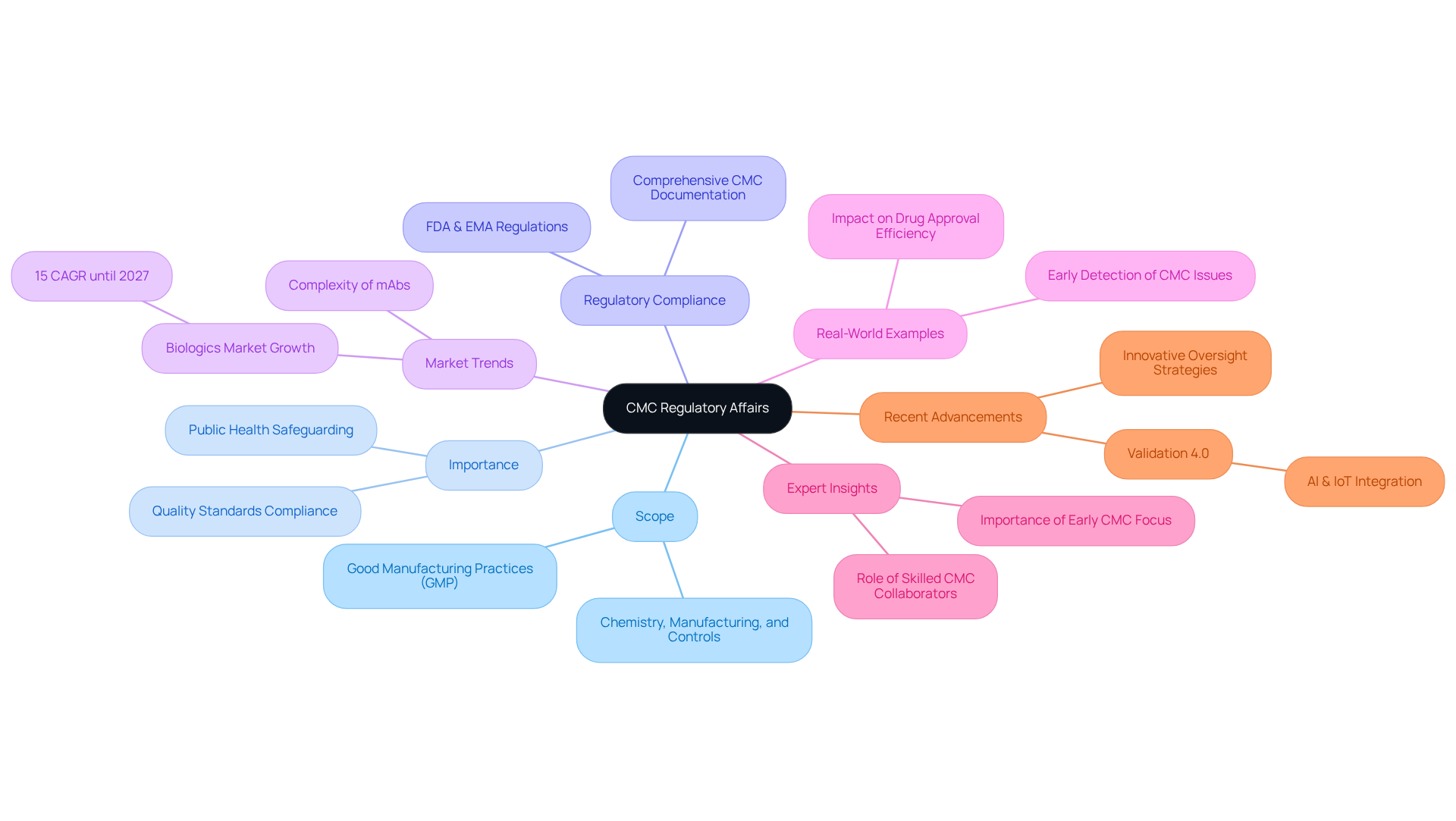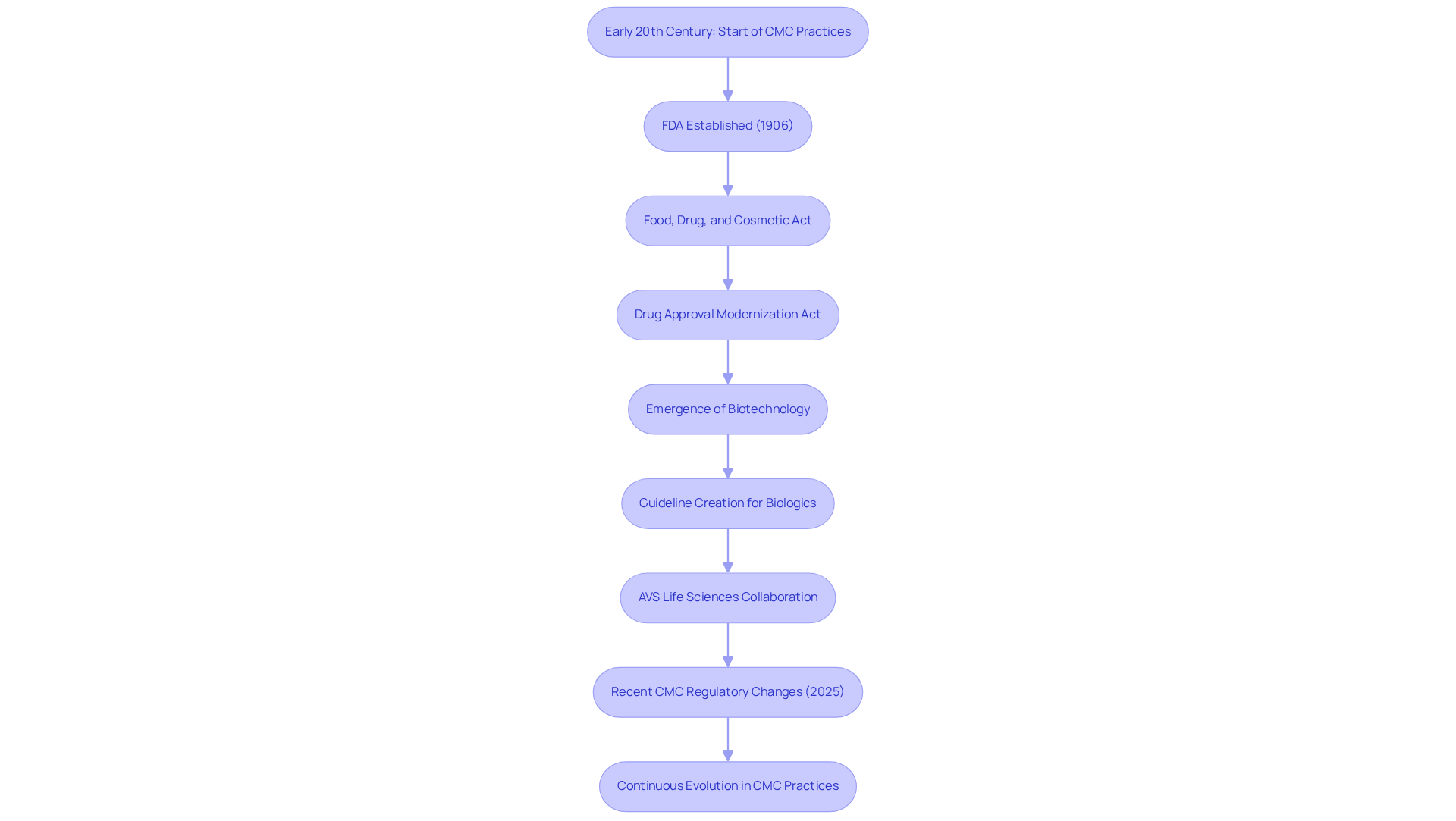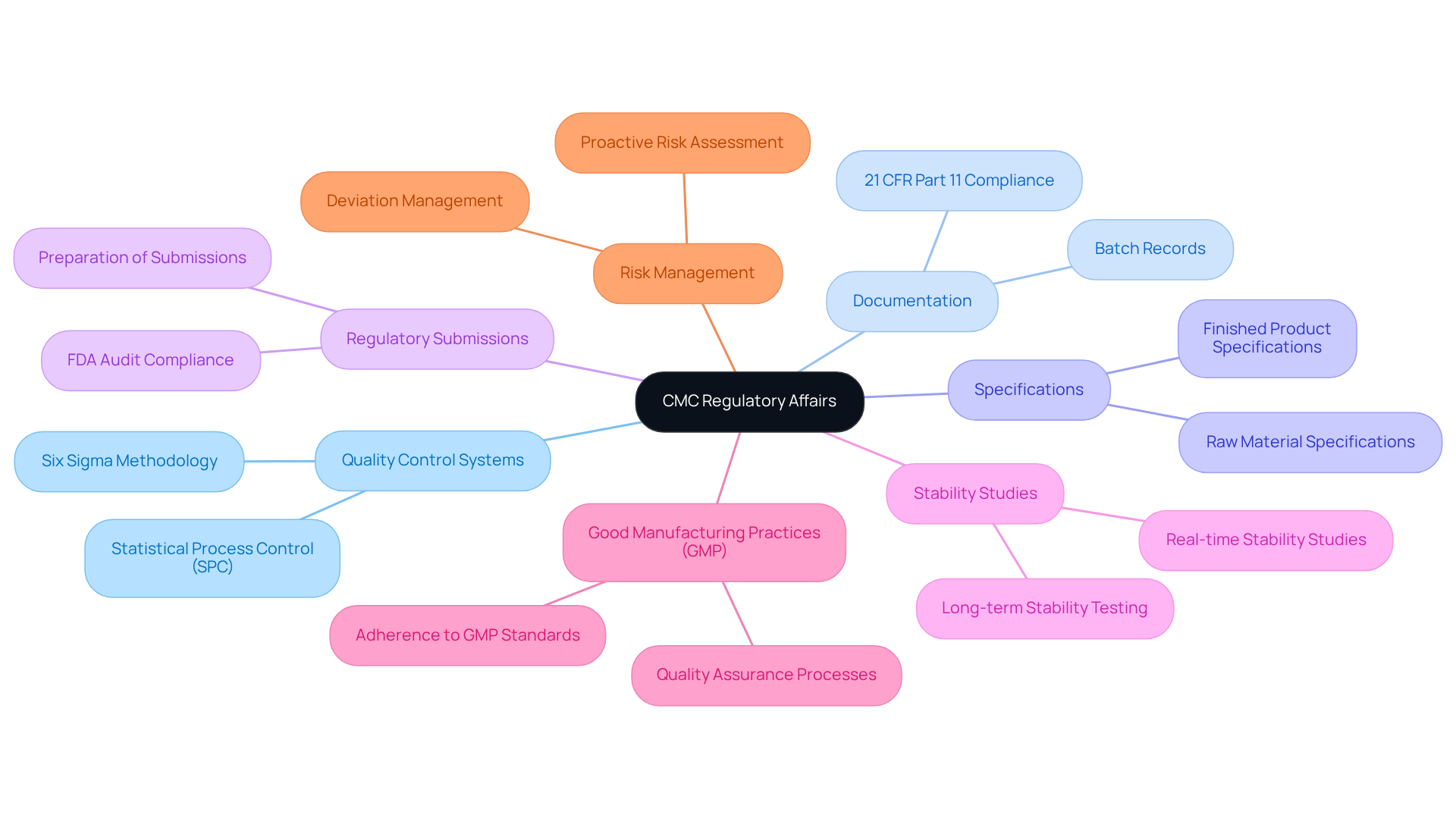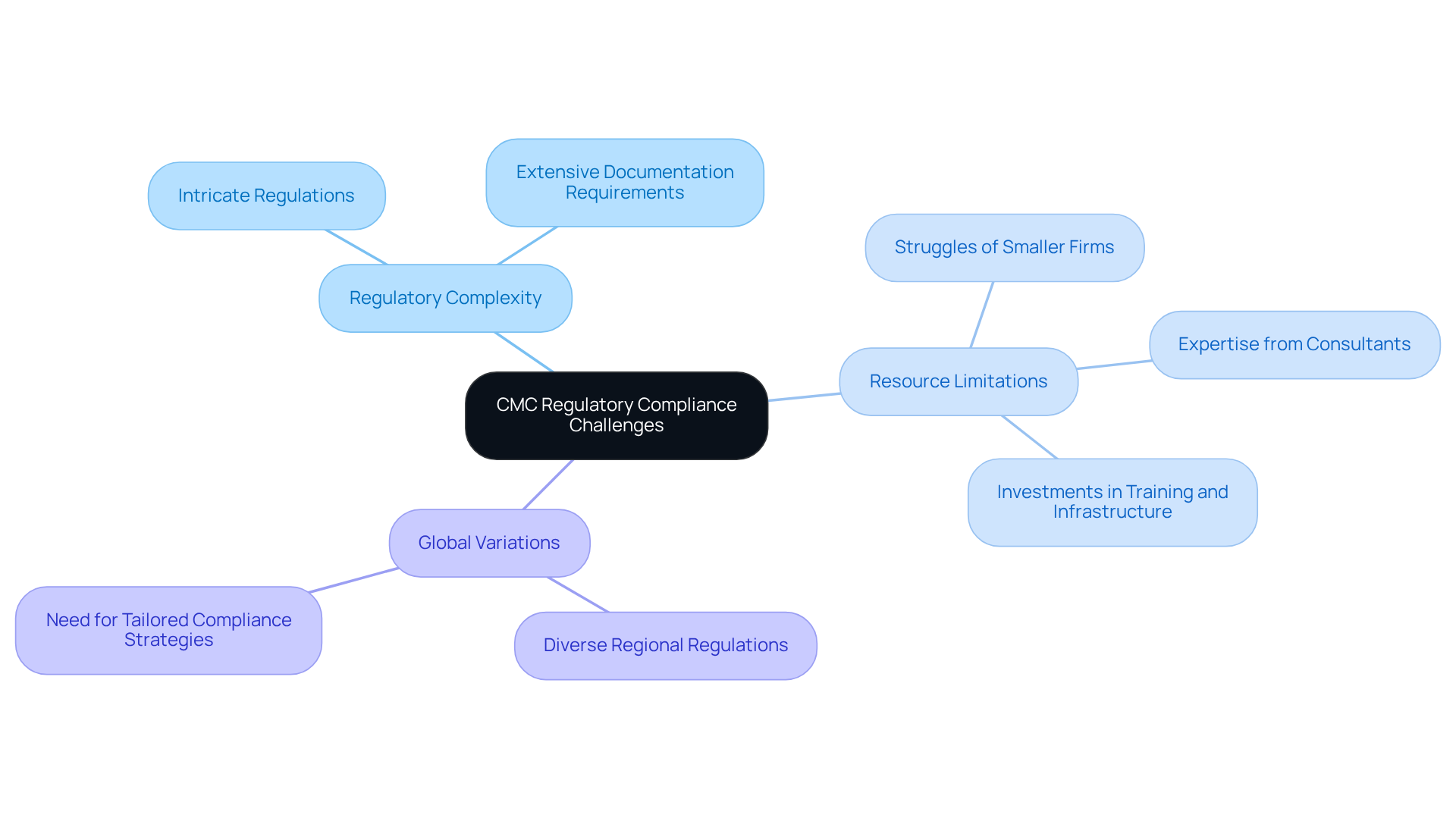Understanding CMC Regulatory: Importance, Evolution, and Challenges

Overview
This article underscores the critical importance, evolution, and challenges of CMC regulatory affairs within the pharmaceutical industry. CMC regulatory compliance is essential for ensuring drug safety and effectiveness. It has evolved through significant historical legislative milestones, adapting to modern complexities introduced by biotechnology. Additionally, it addresses the considerable challenges organizations, particularly smaller firms, face in maintaining compliance amid stringent regulations. By understanding these dynamics, stakeholders can better navigate the complexities of compliance and enhance their operational strategies.
Introduction
The intricate world of Chemistry, Manufacturing, and Controls (CMC) regulatory affairs plays a pivotal role in the pharmaceutical industry, ensuring that drugs are produced with the highest standards of quality and safety.
As the landscape of drug development evolves, so too do the challenges and complexities that organizations face in maintaining compliance with CMC regulations.
Companies must employ effective strategies to navigate these hurdles and address how the regulatory framework has adapted to meet the demands of modern therapeutics.
This exploration delves into the significance, historical evolution, and ongoing challenges of CMC regulatory practices, shedding light on their critical importance in safeguarding public health and accelerating the delivery of innovative treatments.
Define CMC Regulatory Affairs: Scope and Importance
The critical processes and regulations governing the chemistry, manufacturing, and controls of pharmaceutical products fall under CMC regulatory affairs. This domain is essential for ensuring that drugs are consistently produced to meet stringent quality standards throughout their lifecycle. The significance of CMC compliance is underscored by its role in safeguarding public health, ensuring that products are safe, effective, and manufactured in accordance with Good Manufacturing Practices (GMP). Regulatory authorities, including the FDA and EMA, mandate comprehensive CMC regulatory documentation as a prerequisite for drug approval, establishing it as an indispensable component of pharmaceutical development.
Real-world examples illustrate the profound impact of CMC compliance on public health. For instance, the early detection of CMC-related issues can avert costly delays and ensure adherence to regulatory expectations, ultimately facilitating a more efficient path to product approval. The biologics market, projected to grow at a compound annual growth rate of 15% until 2027, exemplifies the escalating complexity of CMC challenges, particularly concerning monoclonal antibodies (mAbs). These complexities necessitate a proactive oversight strategy to effectively manage structural characterization, impurity profiles, and stability.
Expert opinions emphasize that a skilled CMC regulatory collaborator can significantly enhance regulatory efforts, providing insights that address potential gaps and streamline the development process. Recent advancements in CMC oversight, particularly in 2025, highlight a growing emphasis on innovation and efficiency, with initiatives like Validation 4.0 aiming to integrate advanced technologies such as AI and IoT into validation procedures. This evolution not only bolsters compliance but also accelerates therapy development, aligning with the industry's urgent need to deliver new treatments more swiftly while ensuring safety.

Trace the Evolution of CMC Regulatory Practices
The development of Chemistry, Manufacturing, and Controls (CMC) compliance practices commenced in the early 20th century, driven by an increasing demand for drug safety and effectiveness. The establishment of the FDA in 1906 marked a pivotal moment, introducing stringent regulations that laid the groundwork for modern drug oversight. Significant legislative milestones, including the Food, Drug, and Cosmetic Act and the Drug Approval Modernization Act, have progressively refined CMC regulatory requirements, ensuring that products meet rigorous safety and quality standards.
As biotechnology emerged in the late 20th century, oversight bodies faced new challenges, necessitating the creation of guidelines tailored for biologics and complex drug formulations. This shift underscored the need for flexible governance frameworks capable of addressing the intricacies of modern therapeutics.
A transformative example of this evolution is illustrated by AVS Life Sciences' recent collaboration with a leading biotechnology company in San Francisco. AVS facilitated the upgrade of their manufacturing space from a Biosafety Level 1 GMP facility to a Level 2 GMP facility, completing the project on schedule and within budget. This upgrade not only enhanced the client's capacity to produce essential medications but also underscored the importance of assurance and regulatory adherence in the drug development process. AVS employed rigorous methodologies, including comprehensive gap analysis and meticulous documentation practices, which were validated by the client's quality assurance team, demonstrating the effectiveness of their quality management solutions.
Recent changes in the CMC regulatory framework, particularly those issued by the FDA and EMA in 2025, reflect a commitment to enhancing compliance and efficiency in drug development. These updates emphasize the importance of proactive engagement with oversight organizations and the necessity for institutions to uphold adaptable strategies in response to evolving global health demands. Statistics indicate that the FDA now regulates approximately 20% of all U.S. economic activities, highlighting its critical role in shaping the pharmaceutical landscape.
Overall, the trajectory of CMC regulatory governance practices illustrates a continuous evolution, driven by technological advancements and the imperative to safeguard public health.

Identify Key Components and Functions of CMC Regulatory Affairs
Key components of CMC compliance affairs encompass the development of robust quality control systems, meticulous documentation of manufacturing processes, and the establishment of stringent specifications for both raw materials and finished products. CMC regulatory professionals are essential in preparing regulatory submissions, conducting stability studies, and ensuring adherence to Good Manufacturing Practices (GMP) and ISO standards. Their responsibilities extend to risk management, where they proactively address deviations from established protocols to maintain compliance and product integrity.
Real-world applications of control systems in CMC practices demonstrate their significance. For instance, the implementation of Statistical Process Control (SPC) has become essential for monitoring manufacturing processes, allowing for real-time adjustments that prevent out-of-specification results. This proactive approach not only safeguards patient health but also enhances overall product reliability.
Expert opinions underscore the necessity of these systems in the pharmaceutical landscape. As oversight bodies progressively require enhanced monitoring protocols, CMC specialists must adjust to changing standards and expectations. Statistics show that organizations utilizing extensive control measures encounter considerably lower defect rates, with Six Sigma approaches targeting no more than 3.4 defects per million opportunities.
At AVS Life Sciences, we recognize the critical importance of effective CMC compliance practices. Our customized consulting solutions in quality management and adherence to regulations are designed to assist pharmaceutical firms in consistently achieving high-quality standards. By doing so, we reduce risks to patients and strengthen the trustworthiness of the products supplied to the market. Connect with us today to discover how we can assist with your CMC compliance affairs requirements.

Address Challenges in CMC Regulatory Compliance
Organizations encounter significant challenges in adhering to CMC regulatory standards, primarily due to the intricate nature of these regulations and the extensive documentation they require. Smaller pharmaceutical firms, in particular, often struggle to keep pace with the evolving directives from governing bodies, a daunting task given their limited resources. The imperative to comply with Good Manufacturing Practices (GMP) further exacerbates these challenges, necessitating considerable investments in training and infrastructure.
Moreover, the complexities of global regulations, which can vary significantly across different regions, introduce an additional layer of difficulty. To effectively address these issues, many organizations seek the expertise of seasoned consultants who provide tailored guidance and support in developing robust compliance frameworks that meet CMC regulatory standards. This strategic partnership not only facilitates adherence to regulatory requirements but also enhances operational efficiency and mitigates the risk of non-compliance.

Conclusion
The landscape of Chemistry, Manufacturing, and Controls (CMC) regulatory affairs is vital for ensuring the consistent quality and safety of pharmaceutical products. This domain not only plays a crucial role in public health but also shapes the development processes within the pharmaceutical industry. As regulations evolve, so too does the necessity for robust compliance frameworks to navigate the complexities of modern drug manufacturing and oversight.
Key points throughout the article highlight the historical evolution of CMC practices, emphasizing milestones such as the establishment of the FDA and the adaptation to biotechnological advancements. The importance of skilled CMC professionals in enhancing regulatory efforts and the integration of innovative technologies like AI and IoT are underscored as essential for maintaining compliance and accelerating therapy development. Furthermore, the challenges faced by smaller pharmaceutical firms in adhering to stringent regulations are addressed, emphasizing the need for expert guidance and tailored compliance strategies.
In light of these insights, it becomes clear that the significance of CMC regulatory affairs extends beyond mere compliance; it is a critical component that safeguards public health and supports the advancement of new therapies. As the pharmaceutical industry continues to evolve, embracing innovation and collaboration will be key to overcoming regulatory challenges. Engaging with experienced consultants and investing in quality management solutions can empower organizations to navigate this intricate landscape, ensuring that they meet regulatory expectations while delivering safe and effective products to the market.
Frequently Asked Questions
What does CMC regulatory affairs encompass?
CMC regulatory affairs encompasses the critical processes and regulations governing the chemistry, manufacturing, and controls of pharmaceutical products, ensuring that drugs are consistently produced to meet quality standards throughout their lifecycle.
Why is CMC compliance important?
CMC compliance is important for safeguarding public health by ensuring that pharmaceutical products are safe, effective, and manufactured in accordance with Good Manufacturing Practices (GMP). It is also a prerequisite for drug approval by regulatory authorities like the FDA and EMA.
How does CMC compliance impact public health?
CMC compliance impacts public health by enabling the early detection of CMC-related issues, which can avert costly delays and ensure adherence to regulatory expectations, facilitating a more efficient path to product approval.
What are some challenges in the CMC domain, particularly in the biologics market?
The biologics market faces escalating complexities in CMC challenges, especially concerning monoclonal antibodies (mAbs). These complexities include managing structural characterization, impurity profiles, and stability.
How can a skilled CMC regulatory collaborator enhance regulatory efforts?
A skilled CMC regulatory collaborator can enhance regulatory efforts by providing insights that address potential gaps and streamline the development process, leading to more efficient compliance and approval.
What advancements have been made in CMC oversight recently?
Recent advancements in CMC oversight, particularly in 2025, emphasize innovation and efficiency, with initiatives like Validation 4.0 integrating advanced technologies such as AI and IoT into validation procedures to bolster compliance and accelerate therapy development.
